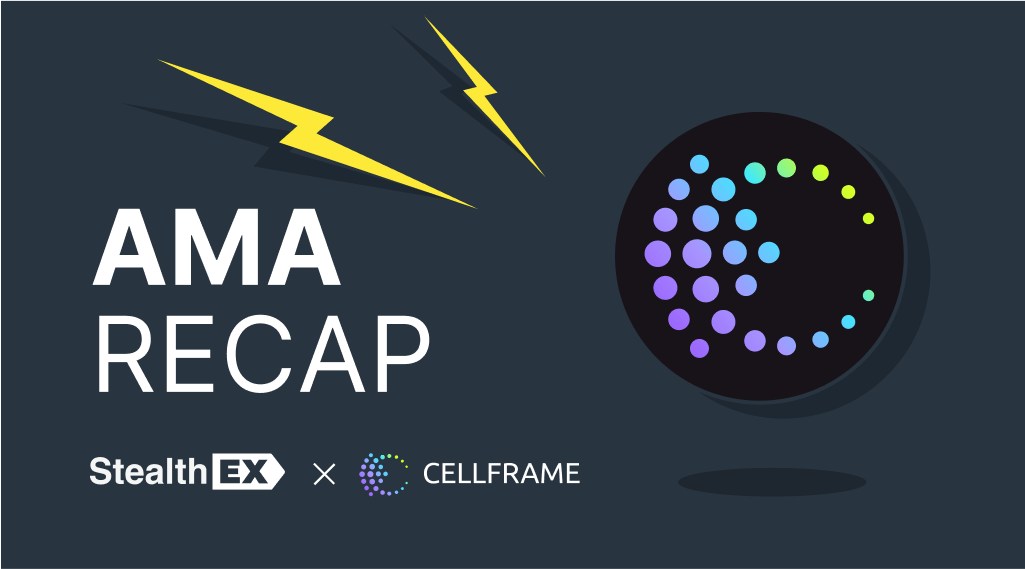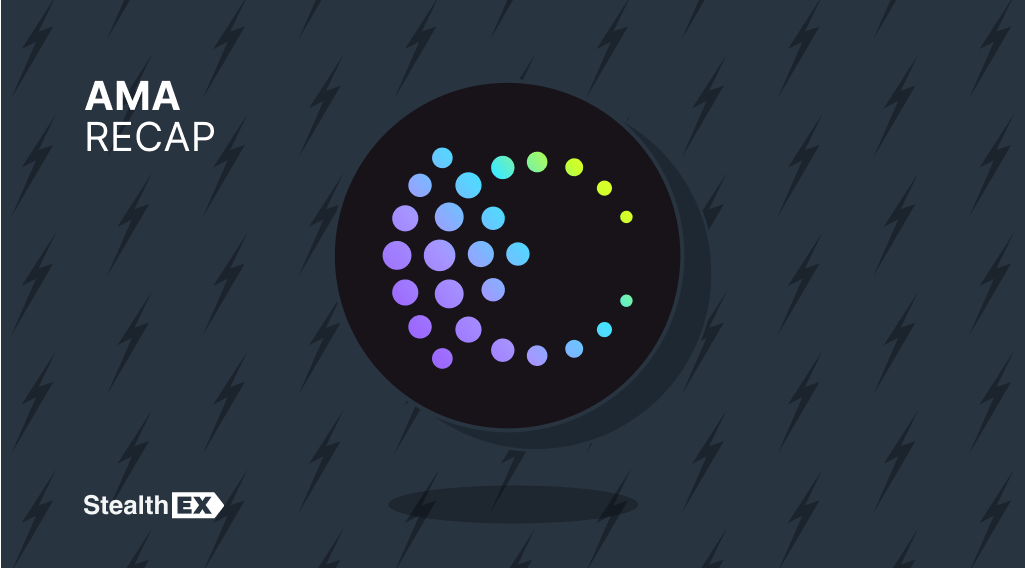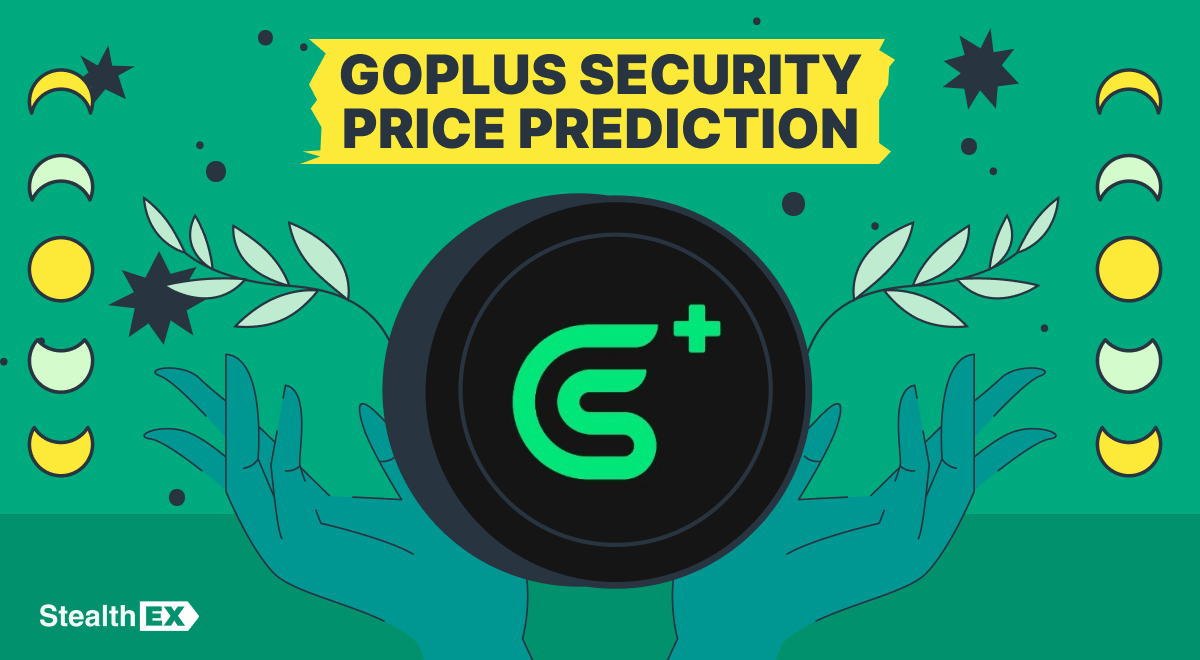Recap of Exclusive AMA: Cellframe x StealthEX

On August 29, 2023, we had StealthEX & Cellframe AMA session in our Telegram Community Chat, and here is a recap.

Our guest was Gleb Sidorkin, Head of Content of Cellframe.
Gleb Sidorkin: Hello sers and madames! Excited for the AMA! Great questions and great project. I like the simplicity of the platform and the design. Excellent content as well, the blog looks great. I will read. And the team has been a pleasure to work with! StealthEX is a gem methinks! 🔥
StealthEX: It’s a pleasure to have you with us today! Let’s get started with the first question.
Questions from Twitter
Q1: Could you provide more information about your future development plans, including how you plan to interact with blockchain systems like Cardano, Polkadot, and Cosmos, as well as how this integration might affect the Cellframe ecosystem?
Gleb Sidorkin: Overall, we post development roadmaps on our socials, and we have fun weekly AMAs on YouTube with CEO and lead architect of Cellframe Dmitry Gerasimov every month or so, so check that out.
Our develpment plans going forward include expanding a variety of services. This includes multimedia streaming services (such as a lightning-fast Zoom beating videoconf service). Also we’re very excited to work on a machine learning/AI training platform.
It will allow group ownership of AI algorithms, and lower the barrier for entry to train ML algorithms by outsourcing it to the community. People will be able to earn from AI training, and put their “metal” (hardware) to good use.
The next big step in development is a bidirectional bridge for Cellframe. And we are already building and testing the integration with Cosmos! The other networks you mentioned are also planned.
Q2: Cellframe’s original C-code and object-oriented programming form the foundation of its core code. How do these design choices contribute to the security and efficiency of the platform, and what are the key advantages of building the code from scratch?
Gleb Sidorkin: Great question. Actually building the code from scratch is one of the best security features we have. A lot of hacks come from copy pasted elements that are integrated by other projects 🙂
Demlabs, which is spearheading the development of Cellframe, has an incredible culture of coding in C an experience which goes back decades
So all the code of Cellframe and the SDK has been combed through and the majority of the vulnerabilities have already been found. The key reason for using C code is a huge advantage in terms of efficiency.
The low level architecture increases speed by many times over other more abstracted languages We’re all about performance.
By building a third-generation blockchain from scratch we were able to take into account things that were missing from previous blockchain projects. For example we are able to implement any type of encryption method at any point.
So even if the post quantum signatures we’re using now end up obsolete at some point and replaced by new ones, we can stay ahead of the game. Most other blockchains like ethereum for example are married to one encryption (which will likely be hacked pretty soon given the exponential rate of quantum computer development) and they will need to do hard forks to stay ahead.
Q3: The statement “Cellframe Network has it all” implies a comprehensive and versatile platform. Can you highlight specific use cases or industries that could benefit the most from Cellframe’s capabilities, and how the network’s offerings cater to a wide range of applications?
Gleb Sidorkin: Yes, we are looking at quite a wide range of industries that could be disrupted. Any kind of digital service that is currently served through centralized means can be improved in terms of performance by decentralization. Think about how torrenting can often be faster than regular downloading because your neighbor might be serving you the file so it gets there faster.
So right now we’re looking at teleconferencing, media streaming, AI training. We already have a VPN service which I believe is the best on the market right now for speed and reliability, and the collaboration or peer-to-peer mode will roll out soon.
KelVPN, which is also being developed by Demlab, is the first active parachain of Cellframe. Decentralization is great because you can improve not only speed but also get around blocks more easily. And you can make money by providing your connectivity to others in the network.
So take that model of a faster, more stable and resilient, and community incentivized version of any digital service, and apply it to anything 🙂
Another important aspect is Internet of things.
Because the code is so lightweight and can run on a tiny device, that’s a huge area where we will have an advantage right away.
Q4: It’s understood the technology for CellFrame has been in development since late 2017. What was the inspiration to build CellFrame and can you give an overview of the unique selling points for the platform which set it apart from other layer 1 protocols?
Gleb Sidorkin: Oh by the way speaking of Internet of Things, Node.sys is a new up and coming project in the Cellframe ecosystem that is geared towards that. It’s really cool it’s a decentralized factory, so we’re also getting into the hardware game! That was to the previous question…
I can describe the origin story of Cellfame as I see it, though I would love to hear Dimitry talk about it more in depth sometime. Hopefully he will come on my show Cellframe After Dark on @cellframesocial soon and I can ask him to tell the whole story.
But basically Dimitry and his collaborators decided that they could apply their engineering mind and low level programming skills to make a much better and more efficient blockchain than currently existed.
They saw that the way the blockchains were being designed was causing all kinds of problems, foremostly lack of speed and throughput, lack of interoperability, and vulnerability to the oncoming quantum threat.
In 2017 almost nobody was talking about quantum computers, and they actually got laughed out of the room by some investors.
But now nobody’s laughing, folks are building quantum computer factories. And who knows, maybe there’s a super fast quantum computer already out there, maybe the US government has a village of scientists hidden somewhere like in that movie Oppenheimer 🙂
I wouldn’t be surprised although I feel like big projects aren’t really being done by the government anymore 🙂
Okay I’m going off on a tangent….
Q5: How does @cellframenet plan to attract web2 and non crypto users to it’s project. What strategy is in place to achieve this?
Gleb Sidorkin: Yes, this is a question that I like talking about a lot. As an industry we keep waiting for mass adoption, why isn’t it here yet? I think there are two sides to this, performance and design.
It’s amazing how many educated people I speak to in daily life when they find out I’m into crypto they get scared and associate it with pump and dump, pyramid scheme, Bernie Madoff, whatever…
An acquaintance of mine was complaining the other day that there were no good VPN options. I told him hey, KelVPN works amazing for me, you should download it!
I should have stopped there… But then I told him that it was also integrated into a blockchain network! He immediately was like no, that’s not for me. He didn’t realize that it’s actually an amazing feature that improves the service.
So for normies we just need to create Kick-Ass services and just like not tell them that they’re blockchain based and then they’ll be using a blockchain without even knowing it 🙂
The other thing is design. There were attempts at versions of the iPhone before the iPhone. Some of them just failed, some got adopted by Hillary Clinton types…
But Steve Jobs, who studied and thought about design seriously, realized that you need to make it sexy.
Big shout out to our co-founder Mira Brezhinskaya who studies design seriously and runs a tight ship in the design department. I encourage you all to download our apps and see for yourself.
Also we have this chipmunk mascot that’s really cute and powerful. Download our sticker sets, reaction emojis, and watch the animated series!!!
Q6: In Blockchain Industry there are 3 core issues: security, scalability and interoperability which will bring competitive advantages to blockchain projects. So, how does your Project will solve these problem?
Gleb Sidorkin: Yes thank you. I already touched on this but this is a good opportunity to sum up. In terms of security we can speak about integration of quantum proof algorithms. The key factor here is that quantum computers have an uncanny ability to crack encryption. It’s weird, we don’t actually know how quantum computers work fully, the fact that they do work is a huge issue for the theoretical physics community because it violates known laws of space-time…
But from a practical perspective the quantum proof algorithms basically just have to be extremely long hashes. the file sizes are orders of magnitude bigger and heavier. Than traditional encryption. So the only way to do blockchain with the signatures is the way Cellfame does it, by getting close to the machine and writing highly efficient C code.
This is a huge challenge for software developers, but it’s a discipline that needs to be maintained to optimize blockchain enough to be able to lift these heavy encryption standards.
As far as security of the code itself, the key aspects are that it’s all built in house and carefully analyzed over years. Machine learning is used to optimize the security of the code. No hacker can ever be as rigorous about our code as we are.
Interoperability is achieved through our layer-zero architecture, I won’t get into the details right now. We have projects like Polkadot out there who are doing this kind of stuff, but we’re faster and better 🙂
The same goes for scalability pretty much! We reach new heights of efficiency over previous attempts.
Q7: Can you elaborate on the system’s performance test results, including the maximum number of transactions processed in a day and the observed consistency of transactions in block periods of CELL?
Gleb Sidorkin: Yes, performance testing right now is still at a baby stage, we’re not even publishing the results yet. We will be focusing on improving speed going forward.
The priority up to now has been security and stability so that we could set up mainnet and start having our community run nodes at a slow speed for now. The block consensus is performing well.
Ultimately the nature of the Cellframe architecture will mean that transaction speed will be limited only by your internet connection speed, not by the software.
This is what we’ve called unlimited speed 🙂 but of course, there will always be limiting factors like hardware and connection.
Q8: How does the dual-layer sharding implementation of Cellframe Network work, and how does it contribute to achieving high transaction throughput compared to traditional blockchain architectures?
Thanks for the question, I’m afraid I can’t give a fully elaborated technical answer right now. We will be rolling out this feature in the coming weeks, and I will have more information to talk about it in detail. A key aspect of the architecture is a distinction between standard nodes and archival nodes. All other kinds of nodes besides the archival ones will not have to store all that archival data.
I’m excited to learn more about technical details of this myself, and I encourage you to put this question into our AMA with Dmitry, I think it’s coming up in about a week
Q9: National Institute of Standards & Technology(NIST) has begun calling for Comments for 3 public-key cryptographic algorithms that made the last round. How will @cellframenet engage its community to be aware of this & also to provide necessary inputs between now and November 2023?
Gleb Sidorkin: Yes this is a great topic thank you. We’re engaging with the youth to bring awareness and energy to the field of cryptography. We’re partnering with a major international cryptographic education program / competition, both as sponsors and as participants in the content side of it.
We will be designing some of the challenges that young cryptographers will be asked to solve. This promotes the field as a whole and also it’s kind of like outsourcing some problems that we want solved and getting brilliant young minds to work on them for free 🙂
But actually maybe if someone makes the breakthrough then they can get paid working for Cellframe.
Q10: Given that Cellframe aims to be both a public blockchain solution and an enterprise solution, can you provide examples of how its service-oriented architecture and unique features make it suitable for addressing the needs of both markets? How does Cellframe balance the requirements of public and private use cases?
Gleb Sidorkin: Yes, we do have a very strong program for white label type services for companies. Demlabs has a huge amount of experience with this.
There are actually some contracts that are confidential where people are using Cellframe SDK to build things and working with our engineers on a contract basis.
We also provide elements of our SDK for free to science. Maybe some of you saw the story that parts of Cellframe code are involved in sensors for a major international project to build a fusion reactor. Fusion energy is really hot right now!
Of course the public blockchain side of it is most important. Get involved in our community, you will see that the public side of it has a lot of excitement around it.

Live Questions
Q1: Staking, NFT is very hottest, do you think you will apply NFT technology to your products in the achieved future?
Gleb Sidorkin: Yes we already have nft architecture in place, just haven’t released it yet. I think the first nfts we put out maybe chipmunk related.
Q2: Is there a KYC requirement for the transactions we will make on the Cellframenet Platform? What documents are required for KYC, if any? Finally, what are the transactions we can do without KYC?
Gleb Sidorkin: No kyc, we’re all about decentralization!
Q3: Are you a global project or local project? At present, which market are you focus on, or is it focused on building and growing to gain customers, users and partners?
Gleb Sidorkin: We’re most definitely global and our community reflects that. We’re using our community to gauge which markets to Target
Q4: The introduction also mentions that the Cellxar studio team is creating an animated series starring the Cellframe Chipmunk character. Can you share more details about this animated series, its themes, and what viewers can expect from it?
Gleb Sidorkin: Yes please follow our socials for more chipmunk adventures! The animation team is amazing.
Q5: We’re currently in the bear market. So As the current market situation is too unstable, it holds investors back. So can you give me some good reasons why I should buy your tokens in this market situation? And also why should your token holder continue to hold?
Gleb Sidorkin: I’m not here to give investment advice or sell $cell, you can join the awesome Cell Mates channel for that. But I can say that… Our token is not held by any big whale investors, it’s pretty much all circulating, and we have a devoted group of holders who know that the team is building steadily and for the long term.
Q6: I want to support your project, Tell us more about the Ambassador Program and in what ways can we participate?
Gleb Sidorkin: Yes please join our main chats and talk to admins about joining the team. Also please refer to our marketing roadmap released about a month ago I think.
Q7: Partnership is always an important factor for every project. So who is your partner? What are the benefits you get from those relationships?
Gleb Sidorkin: StealthEX! Also shout out to Gate, I saw that you guys work with them. They have been a reliable CEX partner for us, great company. Other collaborations are listed on our site in the partners section.
Q8: Can you elaborate on the concept of t-Dapps and how they enable developers to create a wide range of applications that run seamlessly on various devices, contributing to the platform’s versatility and accessibility?
Gleb Sidorkin: We have some good blog posts and also our friend Mika has a good article on his blog explaining them, if you Google it you can find that article. tDapps are a huge step forward for decentralization. Current apps are not actually decentralized, since they’re governed by single smart contract. Our daps are basically plugins without an owner.
Q9: Why you decided to launch your token $CELL sale through Trustswap launchpad? What benefits does this provide and what is your relationship with this company?
Gleb Sidorkin: Yes, big shout out to TS! They’re doing amazing work bringing strong teams from around the world together with investors in a way that overcomes the problems with the first wave of ideas that resulted in so Rug Pulls. They do token lockpos and team kyc, Plus Great tools for investors.
Q10: Staking programme is very important for any project? Can I stake your token? Do you have any plan of starting staking programme?
Gleb Sidorkin: Yes I’m glad you mentioned the staking program. It is very good! Our incredible web development team recently completed it and now it has full functionality.
Q11: I read we can become a validator, can you explain how I can be a validator? What are the requirements/qualifications for becoming a validator? Do you have any criteria for choosing your validators?
Gleb Sidorkin: Sitting up a master node is simple and can be done on basic equipment like Raspberry Pi. You have to have a stable internet connection and any old machine, and just follow the instructions 🙂 we have video on our YouTube and a Wiki.
Q12: Revenue is an important aspect for all projects to survive and maintain the project/company. How have you been able to build a complete project and what is the way to generate profit/revenue of the token? What is the income model?
Gleb Sidorkin: Demlabs is diversified and sells white label solutions in addition to the allocation for development that comes from the consensus and tokenomics. Ultimately this will all move into a foundation/dao model.
Q13: The bidirectional bridge and integration with centralized exchanges are highlighted as upcoming milestones. Could you provide more details about the bidirectional bridge, its significance, and the challenges associated with integrating native protocols with exchanges?
Gleb Sidorkin: Yes bridges are challenging and an important piece of the architecture. Please follow up with our Work logs and AMAs to keep close track of progress on that and technical details.
StealthEX: Thank you everyone for being here, and we hope that you enjoyed the AMA!
You can swap CELL coin on StealthEX exchange platform.
How to Buy Cellframe (CELL) Coin?
Just go to StealthEX and follow these easy steps:
- Choose the pair and the amount for your exchange. For example, BTC to CELL coin.
- Press the “Start exchange” button.
- Provide the recipient address to which the coins will be transferred.
- Move your cryptocurrency for the exchange.
- Receive your crypto coins!
Follow us on Medium, Twitter, Telegram, YouTube, and Publish0x to stay updated about the latest news on StealthEX.io and the rest of the crypto world.
AMA CELL Cellframe crypto world StealthEX exchangeRecent Articles on Cryptocurrency
 Toshi Price Prediction: Will TOSHI Coin Reach $1?
Toshi Price Prediction: Will TOSHI Coin Reach $1?  GoPlus Security Price Prediction: Will GPS Coin Reach $1?
GoPlus Security Price Prediction: Will GPS Coin Reach $1? 
